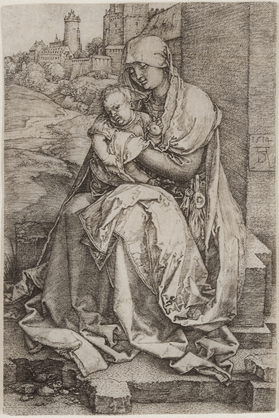There are three basic categories of printmaking: relief, intaglio, and planographic. We've already discussed relief printmaking, now let's learn about intaglio.
Intaglio printmaking is the reverse of relief printmaking, in that the design is carved to hold the ink, then, when the plate is pressed into paper, the paper picks up the ink. To keep these straight, think intaglio = anything you carve into the plate will show up in ink, whereas relief = what you don’t carve shows up in ink.
Intaglio
Engraving
Engraving is the oldest form of intaglio printmaking in which the artist carves into the plate by hand—making it also one of the most challenging printmaking methods to master! The artist uses a sharp steel rod called a burin to draw into a metal plate creating a V-shaped groove where the ink will lay before printing.
Drypoint
Drypoint is an engraving technique (usually on copper) whereby a sharp needle-like tool is used to scratch the plate surface in free strokes similar to sketching. Since the plate surface is only very lightly incised, the lines are not deep and the strokes on the print are often quite delicate. When the plate surface is scratched, rough edges, called a burr, curl out from the furrow and diffuse and blur the ink into soft, velvety lines.
Etching
With etchings, the line is incised using acid rather than the artist’s hand. The artist covers a plate of metal with an acid-resistant varnish or wax ground, then scratches through the ground with an etching needle to expose the metal beneath. Once the design is complete, the plate is dipped in acid, which eats away the lines where the metal has been exposed. The depth of the line depends on the length of time the plate is exposed to the acid. Once the ground has been removed, the metal plate can be inked, wiped, and printed. The immense pressure during printing transfers the ink from the lines on the plate to the sheet of paper.
Aquatint
An etching technique that focuses more on areas of tone and shape rather than line. The plate is first covered in a solution made up of tiny granules of an acid-resistant resin and heated so that the resin wash sticks to the plate. When the plate is then placed into an acid bath, the acid will eat away at the areas of exposed metal between the particles of resin. This creates large areas of incision, so when the plate is inked and printed, planes of color emerge that resemble flat tones of wash or watercolor.









































Opmerkingen